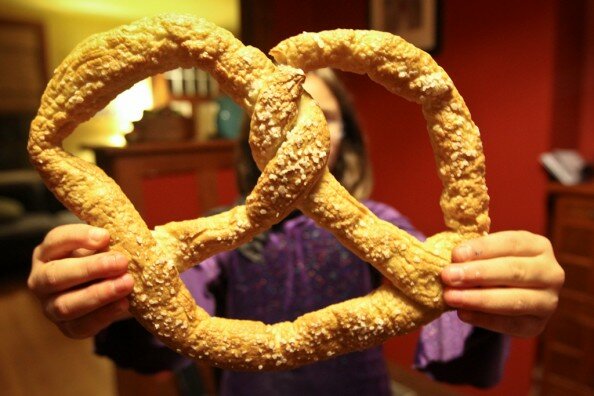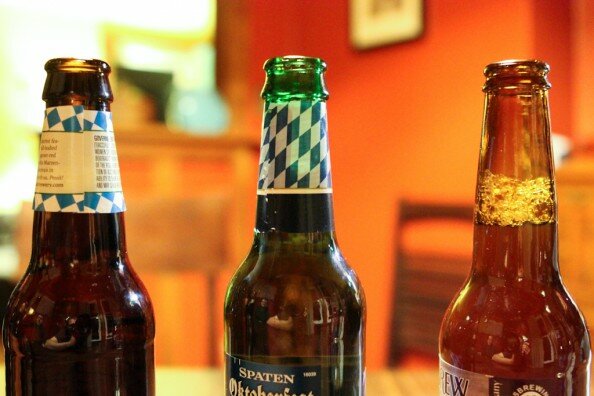
Tag Archives: beer
Celebrate the Season
We don’t need a reason to drink beer. But every year around this time, while thousands of people in Munich, Germany are raising liter mugs filled with tasty lager, we get a little restless. It’s as though a metaphysical force reaches over continents and across the Atlantic Ocean imploring us to party. So it only made sense to gather a few people and attempt to make a batch of big-ass pretzels while drinking as much Oktoberfest beer as we could.
Despite its name, the Munich Oktoberfest is actually celebrated through the last couple weeks of September and ends on the first weekend in October. The festival originated in 1810 to observe the marriage of the Crown Prince Ludwig to Princess Therese of Saxony-Hildburghausen. Today, it is the world’s largest fair and an important part of Bavarian culture. With massive drinking tents, carnival rides, traditional German fare, and an outrageous amount of beer, the festival is known throughout the world.
I was lucky enough to be in Munich during Oktoberfest some years ago. Pictures cannot do justice to the atmosphere in the Hofbräu-Festzelt, the largest of all the beer tents. This tent alone sells around half a million liters of beer and 70,000 roast chickens every year through the 16 day event. Imagine yourself drinking beer all day and singing along with a few thousand new friends while an Oom-pah band plays traditional drinking songs like Ein Prosit and, oddly enough, John Denver’s Country Roads. Apparently, beer drinkers like John Denver.
Naturally, it’s easy to overindulge at Munich’s Oktoberfest. Though I consumed multiple liters and even attempted to pick a fight with an English rugby team on one occasion, I was able to narrowly avoid becoming one of the “Bierleichen” (beer corpses). I did see a couple of people puking into garbage cans but that aspect wasn’t much different than Michigan State’s campus before an afternoon football game.
It’s a once-in-a-lifetime experience to be sure and perhaps one of my fondest memories was eating soft pretzels the size of a small Rottweiler.
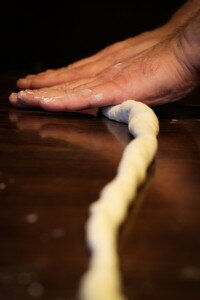 There is no big secret to making a decent soft pretzel. It’s just bread that gets a quick bath in boiling water before baking to create a deep-brown outer crust. Making those authentic, big-ass Oktoberfest pretzels is a different story, and our experiment didn’t quite turn out as anticipated. Handling the large twists of delicate dough after the water bath requires some specialized equipment. We were able to accomplish the water bath using a shallow, extra large stainless pot with a deep-frying basket. Though big-ass pretzels are quite impressive, we suggest going a less demanding route and making them small enough to handle with a slotted spoon.
There is no big secret to making a decent soft pretzel. It’s just bread that gets a quick bath in boiling water before baking to create a deep-brown outer crust. Making those authentic, big-ass Oktoberfest pretzels is a different story, and our experiment didn’t quite turn out as anticipated. Handling the large twists of delicate dough after the water bath requires some specialized equipment. We were able to accomplish the water bath using a shallow, extra large stainless pot with a deep-frying basket. Though big-ass pretzels are quite impressive, we suggest going a less demanding route and making them small enough to handle with a slotted spoon.
Recipe for 1 dozen 6-inch Pretzels
Ingredients:
- 2-3/4 cups flour
- 1 tbsp Yeast
- 1 tbsp Sugar
- 1 tsp Salt
- 2 tbsp softened butter
- 1 cup warm water (~115 deg F)
- Coarse salt (we like thin, flaked salt. Try Davids Kosher)
Steps:
- Combine the water and yeast in a mixing bowl. When dissolved and beginning to froth, add 1-1/2 cup flour and remaining ingredients. Stir until thoroughly mixed.
- Stir in the remaining 1-1/4 cup flour and knead until the dough loses its stickiness. Let the dough rise in a covered, greased bowl until it doubles in bulk.
- Punch down the dough and divide into 12 pieces for traditional pretzels or two pieces for big-ass pretzels.
- With your palms, roll the 12 pretzel pieces into 18-inch lengths about the thickness of a pencil, tapering the ends slightly. Loop the 18-inch length into the traditional pretzel shape, and place on a greased baking sheet.
- Cover pretzels and allow the dough to rise until approximately doubled in bulk.
- Preheat oven to 475. In a non-aluminum saucepan, prepare a boiling solution of:
- 4 cups water
- 5 tablespoons baking soda
- With a slotted spoon, carefully lower the pretzels into the water for about one minute.
- Return the pretzels to the greased baking sheet (or alternately, a baking sheet lined with parchment paper or silicone mat) and sprinkle with coarse salt.
- Bake the pretzels until they are browned, about 12-15 minutes.
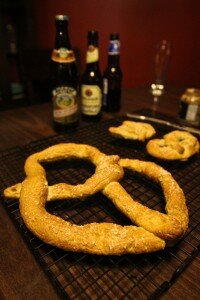 Serve with mustard and beer. Which beer? We’re glad you asked.
Serve with mustard and beer. Which beer? We’re glad you asked.
Oktoberfest beer, or Märzen, is a style that was traditionally brewed in spring to be cellared over the summer months. The alcohol content was slightly higher to prevent spoilage. It should be malty, clean, and deep golden to amber in color with no little to no hop flavor or aroma.
Because of the many American craft breweries that make a seasonal ale and call it an Oktoberfest, there is a common misconception that these beers should be deep amber to brown in color, fruity, and sometimes even hoppy. While we’re certainly not beer style fascists and like to take a beer on its own merit as well as compare it to a style, it does get annoying when some beer geeks disparage the lighter German Oktoberfest beers for not being made “to style”. It helps to remember that the Germans invented the damn style and imported German Oktoberfest beer is always a lager and will generally be lighter and cleaner than their American counterparts.
The official Oktoberfest may be over in Munich but many of the beers will remain on store shelves well into November. Drink up.
The Beers
Short’s Noble Chaos: Musty, grainy, and chocolate-y, this lager shows why most American breweries don’t even attempt true Oktoberfest lagers, opting for malty ales instead.
Spaten: Nicely balanced and light bodied, this finishes with a moderate bitterness. Not a remarkable beer but it’s a drinkable brew in a style that can sometimes be a bit too sweet. It’s possible our sample bottle had a bit of skunk. I’m not paranoid of beer in green bottles — but if they are sitting on a warm shelf under lights, buyer beware.
Harpoon: One of the better American Oktoberfests we sampled, this was more “on style” (in the German sense) than most of the other new world selections. Lighter than most, it was nevertheless malty, a tad fruity, and on the sweet side. Quaffable.
Ayinger: Sweeter and fuller bodied than most of the Germans, this would be hard to drink en masse, but it has its own merits: There’s a lot of depth to the malt characteristics, and for all the sweetness, it finishes fairly dry.
Bell’s: Smells and tastes a bit soapy with a grainy and bready texture. This one had a somewhat unfinished quality to it.
Hofbrau: Arguably the lightest beer in terms of body, it’s still quite malty. While it’s not as sweet overall as some others, it has no bitterness on the finish to clean it up so it comes off as awkward.
Sam Adams: We were pleasantly surprised by this beer, which has historically come off to us as a lower tier effort in the style. Compared to the Hofbrau, which preceded it, the Sam was notably weightier in body but less sweet overall. We went back to this later, and while coming after the Hofbrau was a favorable spot in the line-up, it still tasted surprisingly good later. Slightly more hop presence than the Germans, however.
Frankenmuth: Though drinkable outside the context of a tasting, this local version has an off flavor that makes it mediocre at best.
Schmohz: If the Short’s was a bit off style, the Schmohz shows a blatant disregard for what can reasonably be called Oktoberfest. A dark wheat beer, it was laudably dry, but it tasted like an amateur homebrew.
Paulaner: Almost unanimously the best of the Oktoberfest beers, this had the best balance of malt sweetness up front and a dry, lingering finish. As with most lagers and despite the intentional sweetness, drinkability is paramount with Oktoberfest, and Paulaner hits the sweet spot. Even after going back to the other German beers, this stands out in a casual re-tasting.
Weihenstephaner: Though not a part of our tasting I felt it important to mention this beer as I’ve consumed nearly two cases since the season began. With a malty, full body and just enough hop bitterness for balance, this is one of the more drinkable offerings out there.
Images and the bulk of tasting notes provided by Evan Hansen.
Meet Cool People, Drink Beer, Help Tashmoo Biergarten
Tashmoo Biergarten is a pop-up, European-style biergarten that will be serving fresh, local beer in Detroit’s West Village for five Sundays this autumn beginning on September 25th. The hours will run from 12pm – 9pm. Alongside the beer will be a small amount of food and non-alcoholic beverages from Great Lakes Coffee.
They’re looking for volunteers to help with several aspects of the project.
Bottling beer:
Have you ever been curious as to how tasty beer gets into a bottle? Here’s your chance to find out. Work a seven hour shift at MilkingIt in Royal Oak bottling beer for Tashmoo and not only will you gain a unique experience, FREE BEER will be provided as you work. Enough said, right?
Build the biergarten:
Tashmoo is also looking for folks to cut and drill lumber, assemble tables and benches, and assemble a pallet fence. Imagine bringing your friends to a session at the biergarten and setting your suds upon a table that you constructed with your own fortitude. You’ll be like the hero in a James Cameron film.
If interested in helping out, contact Tashmoo Volunteer Manager Matt
Clayson at
Tashmoo BierGarten
Some Things You Should Know About Booze
- Corona does not contain urine from Mexican factory workers, it just tastes that way.
- Old wine is not necessarily better. The vast amount of wine produced is meant to be consumed within a year or two after bottling. Also, if you have a habit of sniffing corks at a restaurant, there’s a 98.6% chance that most people think that you’re a douchebag.
- Drinking absinthe will likely cause hallucinations if you drop a hit of LSD prior to imbibing.
- Mixing beer, wine, and liquor does not get you more wasted. Drinking excessively gets you more wasted. It’s science!
- Bock beer does not come from the bottom of a barrel, it is a traditional German high gravity lager (not to be mistaken for Steel Reserve, St. Ides, Hurricane, or Olde English).
- Pink wine (rosé) is not just for girls, unless it’s Sutter Home White Zin.
- A martini is the name for a cocktail made with gin and vermouth. A vodka and vermouth cocktail is called a Kangaroo. A vodka and Sour Apple Pucker cocktail is called bad judgment.
- “Liquor before beer, never fear. Beer before liquor, never sicker.” – You get wasted, you puke, nothing mysterious about that. Though frankly, I’d rather puke beer, so perhaps there is some wisdom there.
- Cold is not a flavor in beer. It is a description of something that has little or no warmth, like a Coors ad campaign.
- Bonus fact: Drinking Skinnygirl™ Margaritas will cause legwarmers to sprout from your shins.
The USDA Presents: Choose My Glass
The food pyramid is gone. So needlessly complicated, and it legitimized mass processed sweets at the top. What gives? Thankfully, the USDA has released the new “Choose My Plate” program, which simplifies and clarifies what Americans should be eating.
But for all their hard work, they clearly overlooked an important part of the meal experience — drinks! So we at GUD have put together a similar graphic that we’re sure the USDA will approve and adopt any day now: Choose My Glass.
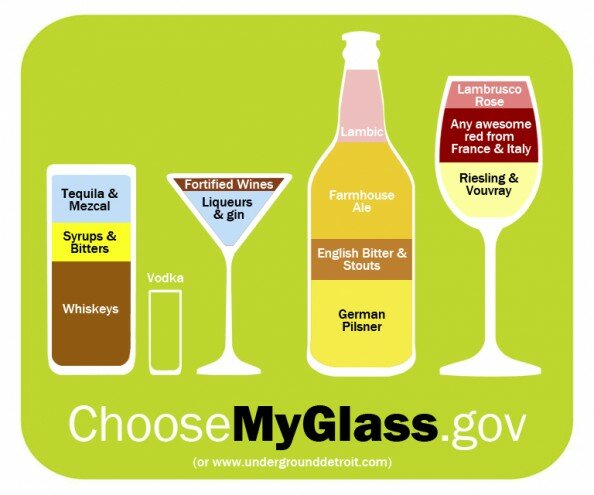 For reference, the original US government diagram:
For reference, the original US government diagram:

Pssst. I Don’t Like Oberon.
Not the King of the Faeries. The beer. I don’t like the beer.
Today, Monday the 28th, marked the release of Bell’s Oberon, which has become such an event that bars in Michigan hold Oberon parties, tapping the kegs at midnight — almost as though beer geeks were waiting in line for the latest Justin Beiber album.
I imagine it might seem needlessly contrarian to pick on such a widely loved beer on such a widely loved day, but someone has to mention the obvious: Oberon is one of Bell’s worst beers.
Yes, it’s citrusy. Yes, you can put an orange peel in it. Yes, it’s a wheat beer with a summery flair.
I care not a lick.
Because Oberon isn’t actually refreshing or subtle or graceful or any of the things I look for in a summer beer. It’s rather the opposite: heavy, sweet, overly hopped, yeasty on the finish. Give me a Kapuziner Weissbier or a Ayinger Weisse over Oberon any day of the week. These are beers that have stood the test of time, recipes refined to be more elegant platforms for the esters and phenols that make that uniquely fruity, spicy flavor that I enjoy in a real wheat beer.
Oberon has none of that. It’s simply better than most bad beer.
Of course, you’d never know that from the excitement over today’s release and the catchy signs that Bell’s has printed over the last half decade. Watching the hysteria, you’d think each bottle contained a personal invitation to come party with Beyonce and Jay-Z. But it doesn’t. It’s just beer. And not even great beer. As Todd pointed out on Twitter earlier today, Oberon is generally occupying a tap handle that could be occupied by a better Bell’s product — anything from the Amber to Two-Hearted would be preferable in my book — and that’s a shame, because Bell’s makes some fine beer. Just not this one.
I’m anti-hype, and I’m anti-Oberon. But not the King of the Faeries. Just the beer.
Beer vs. Wine: the phony debate
“All generalizations are false, including this one.” ~ Mark Twain
Hoppy, smoked, sour and everything in-between, I love craft beer. I have less regard for some craft beer drinkers. In the many years of following conversations relating to all things alcohol, I have found it is the craft beer drinkers that most often rely on disparaging their counterparts, particularly in the sphere of wine, to express their opinions.
So it goes with this latest invective by Stone Brewing Company co-founder Greg Koch pronouncing that the pairing of cheese with wine is a great myth.
I’ve touched on this subject before with what I believe is a far more nuanced article about whether one should choose wine or beer to pair with food. As with any broad topic, the truth is beyond measure, or at least heavily obscured by the many trades with a stake in the matter.
I get the whole Stone Brewing you’re-not-worthy shtick. And it’s obviously in Koch’s business interest to proclaim the superiority of beer over wine. But the attack on the “snobby, stuffy world of wine” and wine drinkers as mostly “oh-so-desperate-to-be-sophisticated housewives of Orange County” illustrates that Koch has only a base level understanding of wine and wine drinkers. The combination of arrogance and ignorance might work well for cable television politics but it comes across as ridiculous in any genuine conversation.
Koch does acknowledge that the possibility of a decent wine and cheese pairing exists before venturing “an educated guess that 99.9 percent of the time, you can find a far superior craft beer pairing”. Who exactly is the pseudo-expert here?
Perhaps the thing that puzzles me most is that this Koch fellow seems to have more than a passing interest in the food movement that rejects the industrialized system in favor of fresh and local. Yet the entire basis of his assertion employs the same tactics, aimed at the reptilian brain, used by the light beer industry he ostensibly scorns. Is it that difficult to make the case for pairing cheese with beer on its own merits?
I realize that much of Koch’s article was written tongue-in-cheek. Before you simply dismiss me as a curmudgeon it is important to remember that Koch is a respected figure in the craft brewing industry. He has the ear of many drinkers that have only recently found their way into quality beer from the macro-brewing wasteland. Why waste that voice on a phony debate?
Cold is not a flavor found in beer
A Brief History of Cold Beer
Cold-fermentation and aging, or lagering, of beer began sometime around the 16th century. To avoid bacterial infection that rendered beer undrinkable, Bavarian brewers were required by law to brew only during the cooler months of the year, between September and May. Throughout summer the beer was stored in deep, stone cellars, sometimes under ice. The yeast adapted to this environment and the result was beer with better clarity and a rounder flavor. Probably served around 50º F straight from the cellar, the beer was cool and tasty.
With the advent of more sophisticated malting techniques, the industrial revolution and artificial refrigeration, lager beer saw a period of rapid growth and soon replaced ale as the beer of choice around most of the globe. Like so many food items during this period of economic expansion, beer changed from a craft product to a commodity overnight. Lower drinking temperatures were part of the bargain.
It didn’t take long for green-eyed entrepreneurs to realize that the colder beer was served, the less that could be tasted. Beer was poured colder and colder, slowly becoming blander and cheaper to produce. Beer drinkers barely seemed to notice. Soon, large rival breweries were pitting their homogenized products against each other, backing up the battle with advertising dollars. It is now to the point where, through clever marketing campaigns, we believe cold is actually a flavor. Could it be that the “coldest tasting beer in the world” is, in reality, nothing much more than flavored alcoholic sparkling water?
How Cold Should We Drink Beer?
If you prefer an ice-cold, refreshing drink to also have some booze in it than you can’t go wrong with just about any domestic lager or light lager at 35º-40º F. Most of the big brand import lagers will also fall into this category. This type of beer is engineered to get through a factory system quickly and be consumed as cold as possible. Any inherent flaws from acceleration of a natural process will be more apparent at higher temperatures and the reason most of us believe warm beer tastes like ass.
A good German or Bohemian-style pilsener or craft-brewed domestic lager like Bell’s Lager of the Lakes will be excellent at 40º-45º F and will reveal subtle malt flavors as it warms in the glass. Heartier Bock and Dopplebock lagers should be drunk even warmer to highlight their creamy malt flavors of caramel and ripe red fruits.
Not all beer is lager. In the cooler north of Europe a tradition of ale drinking has been maintained throughout Belgium, northern France and the British Isles. Ales are fermented much warmer than lagers and so display their myriad yeast characteristics – from tropical fruit to spice – at a higher serving temperature. There is a common misconception that English beer is warm and odd. English cask ale is not warm. It is cellar temperature, less carbonated, much of the time lower in alcohol than most beer, and worth seeking out. Berkley Front, Dragonmead and Slows are a few of the local joints where you can score a pint of cask ale.
Many of Detroit’s brewpubs and microbreweries focus on English-style ales, stouts, porters, old ales and barleywines. If you’re drinking these ice cold you are tasting hop bitterness and not much else. 45º-55º F is more like it. Most French country ales should be consumed at 50º-60º F and beyond. It’s the same for Belgian Trappist and specialty ales. Don’t take our word for it. Collect a variety of beer, a thermometer, and a friend or eight in the name of science.
Brew Your Own

The desire usually starts with some kind of revelation. Mine was in the early ’90s at a tattoo parlor on Spain’s Costa del Sol, where an old, salty machinist with a bottlebrush moustache brought me a glass of roasty Guinness Extra Stout to sip on while I was being inked. He had hoped to make my face pucker with a shock of flavor unlike that of any mass-produced American beer I had been drinking up until then. The opposite happened.
Just like that, a vast world of beer appeared before my eyes — and I spent the next dozen years trying hundreds of diverse brands and styles of beer, everything I could get my hands on, the journey peaking with a half-liter hoist to the oompah band playing “Take Me Home, Country Roads” to an international crowd of thousands partying underneath the grandest beer tent in the world at Bavaria’s Oktoberfest.
The next natural step was to brew my own.
Ever since civilization’s founding members discovered that soggy grain would eventually ferment into an intoxicating gruel, man has been brewing beer at home. For millennia, brewing was mostly a domestic pursuit, first with the Egyptians and Mesopotamians, on to the Greeks and Romans, and eventually into medieval Europe, where alewives served thirsty villagers, and nearly everyone drank beer — because it was safer than water.
Homebrewing in the United States was fairly common in the colonial era until thousands of commercial breweries popped up during the Industrial Revolution. It saw a short gain in popularity again during Prohibition, when breweries were no longer able to sell beer, though some, like Detroit’s own Stroh’s Brewing Company, stayed alive in part by selling cans of hop-infused malt syrup for baking purposes (wink, wink).
In fact, homebrewing was illegal then and stayed illegal until Congress signed a bill in 1978 allowing states to drop restrictions on homebrewing. Today, most states permit households 100 gallons of beer per person for personal consumption, except, of course, Alabama.
About five years later, nuclear engineer Charlie Papazian would pen The Complete Joy of Homebrewing, for years the only mass-market volume to present detailed information on brewing small scale in your home and eventually known to fervent do-it-yourselfers as the “Homebrewing Bible.” Though not without its pages of technical charts and data, Papazian advocated a laid-back approach to brewing and, above all, to “Relax. Don’t worry. Have a homebrew.” These days, there’s no shortage of books on the subject, but you’ll still find fans of Papazian’s tome crafting batches of “Goat Scrotum Ale” from the recipes section.
Through the ’80s and ’90s, tens of thousands of zealous homebrewers discovered that beer didn’t have to be the watery yellow swill the macrobreweries were pushing, and they promptly shouted this declaration to all their friends through a bullhorn. It wasn’t long before the demand for better, more flavorful beer spurred the craft brewing revolution. After all, homebrewers are also great consumers of beer, always looking to taste something new, perhaps with a clever name and a bit of history attached.
This was a time when scores of brewpubs and microbreweries were being started, many by homebrewers. Seriously passionate folks like Larry Bell, who founded Kalamazoo Brewing Company as a homebrewing supply shop in 1983. It’s now known as Bell’s Brewery and you can find a six-pack of Bell’s in just about every beer store in Michigan and gas stations too.
It doesn’t take much to become a homebrewer, other than a nagging desire to craft your own versions of the world’s best beers — and a few pieces of relatively inexpensive equipment. At the most elementary level, it’s possible to brew a batch of beer with only a large stockpot, a can of hopped malt syrup similar to what Stroh’s sold during Prohibition, a small packet of dried ale yeast and a plastic bucket to ferment it all in.
Most who catch the fever will be ever-expanding their equipment. It will start with minor things, like bottle-cappers and immense stir spoons that will have you looking like one of Macbeth’s witches at the cauldron. Six-gallon glass carboys with airlocks will reduce the risk of contamination by outside microfauna. An old cooler can easily be converted into a small “lauter tun” that will allow you to use cracked barley grains instead of malt syrup.
Once you move from malt syrups to an all-grain system of brewing, you can easily make quality, high-octane and tasty brews for a fraction of the cost of commercial beers. A little careful planning and it’s possible to bring costs down to around $2.50 per six-pack. Some brewers will even go as far as creating dispensing systems out of old refrigerators and soda kegs, foregoing the bottling stage altogether. These people always have ample supplies of homebrew and easily make good friends.
Homebrewing isn’t limited to just beer. Michigan grows apples aplenty; during harvest season it’s easy to find mills pressing unpreserved and unpasteurized juice, usually containing enough natural yeast to begin fermenting of its own accord and producing a dry, tasty cider. Fresh grape juice is a little harder to come by in this region, but homebrew supply shops sell a wide variety of concentrates, if making wine is more your speed. And then there is mead, or honeywine, the drink of Greek gods and Anglo-Saxon heroes. Honey is a near perfect vehicle to ferment with all sorts of fruits or spices.
There are so many reasons to brew your own: a deep connection to your ancestors, cost savings, the ability to tweak recipes to your taste or merely getting your friends drunk while bragging about your own skills. Is there a more righteous hobby? The only question is where and when your revelation will appear.
This article first appeared in the Metro Times
Spruce Campbell Ale: A Spruce Beer Recipe & Notes

Spruce Campbell Ale is a unique bottling flavored with spruce tips harvested from our own backyard tree and named after ‘B’ Horror movie icon Bruce Campbell of Evil Dead fame. Tart and refreshing with a touch of malt sweetness, it is reminiscent of a Flanders Red Ale.
Fresh Spruce tips are picked in early May and used right away or frozen until brewing time in late summer. You might imagine a beer brewed with spruce tips would taste like pine resin but in fact the tips add a citrus-like flavor and acidity akin to lemon. The tips also contain tannins which help structure the beer. There are no hops used.

The malt bill is based on a Bell’s Best Brown clone. I don’t recall why I chose this particular malt base but it couldn’t have worked out any better. The resulting balance is rather wine-like which may account for its popularity among people who aren’t serious beer drinkers.
Famous among a half dozen of my close friends, the word about Spruce Campbell’s delicious intensity is spreading like wildfire across internet communities. Actually, only one person asked me for the recipe but I wanted to post the pretty pictures again.
Recipe for six gallons of Spruce Campbell:
5 lbs. pale malt
2 lbs. Maris Otter
1 lb. Victory
1 lb. caramel 60°L
14 oz. special roast
2 oz. chocolate
Single infusion mash. Add 0.75 oz. of spruce tips at 60, 45, 20 and 10 minutes boil for a total of three ounces. (Spruce tips can be adjusted down to as low as 1.5 ounces for a less sour beer)
Best enjoyed during an Evil Dead Trilogy marathon.
